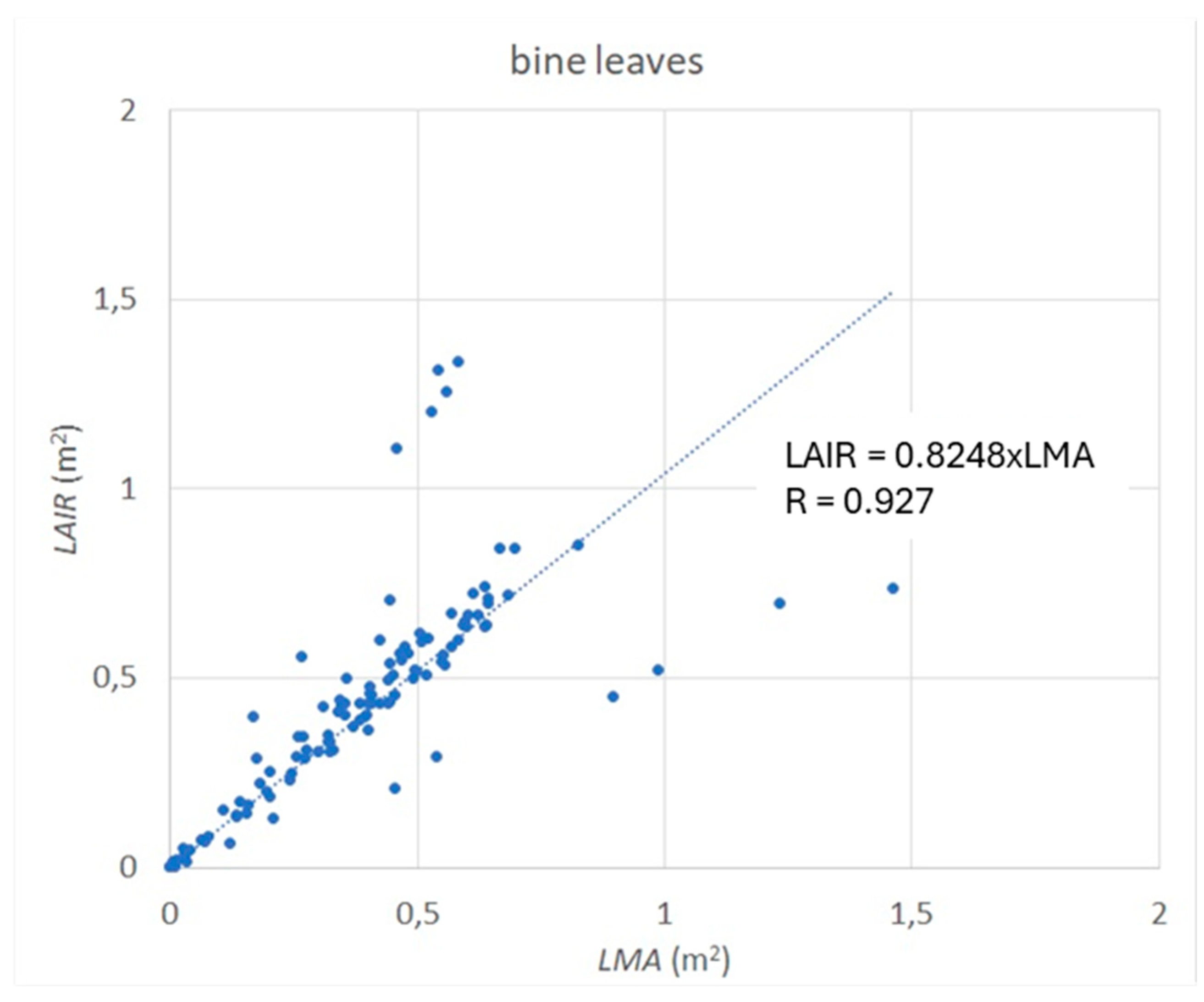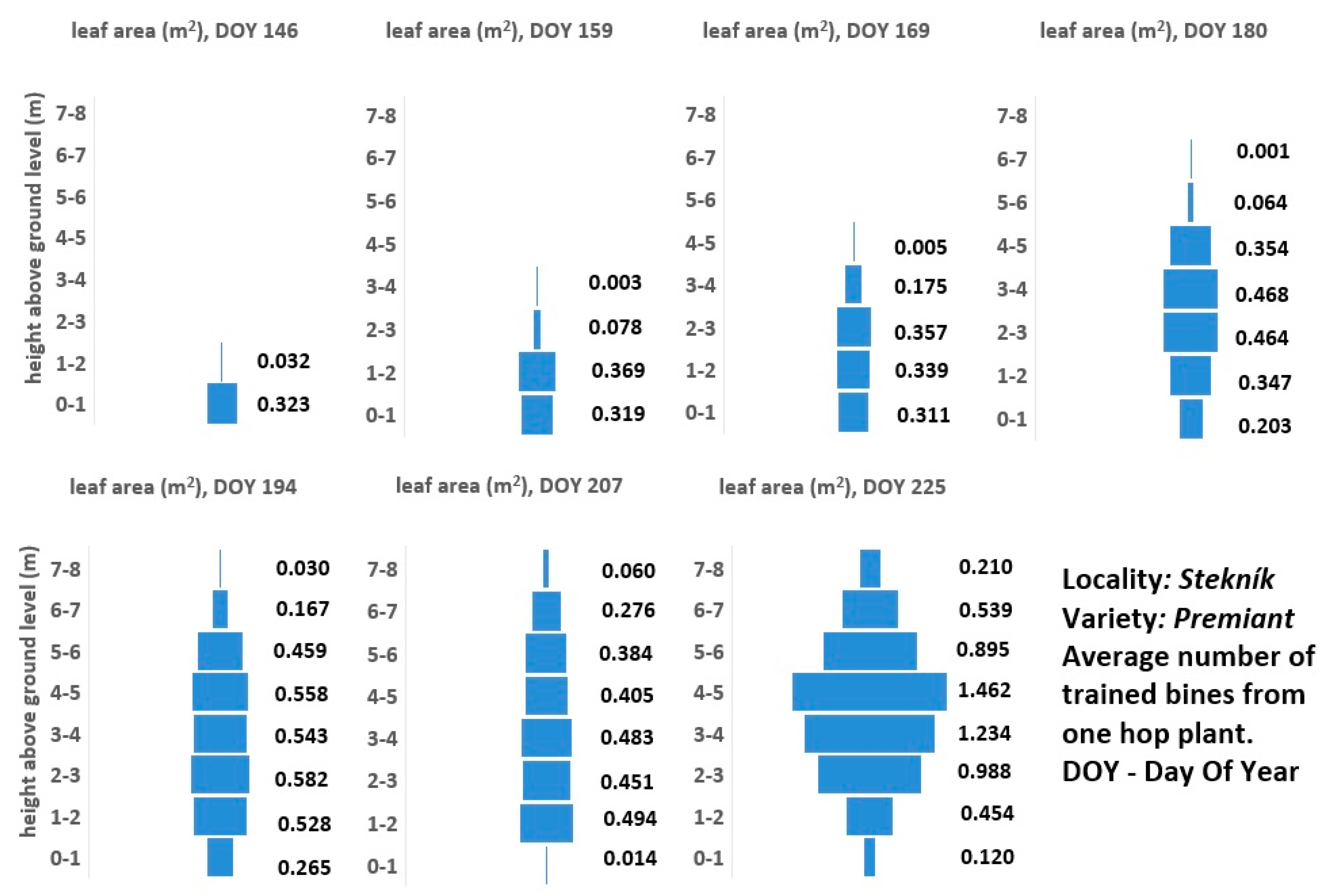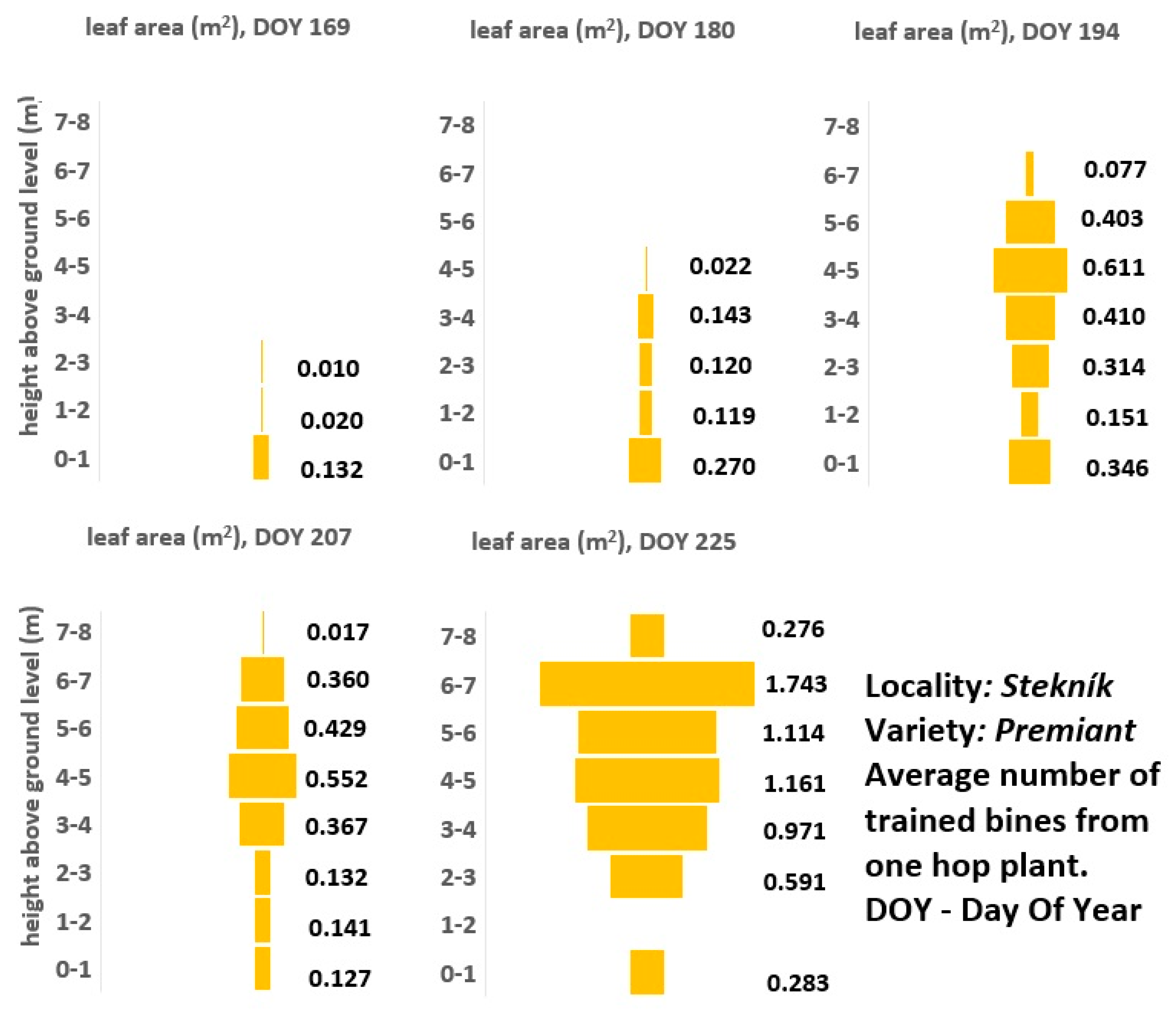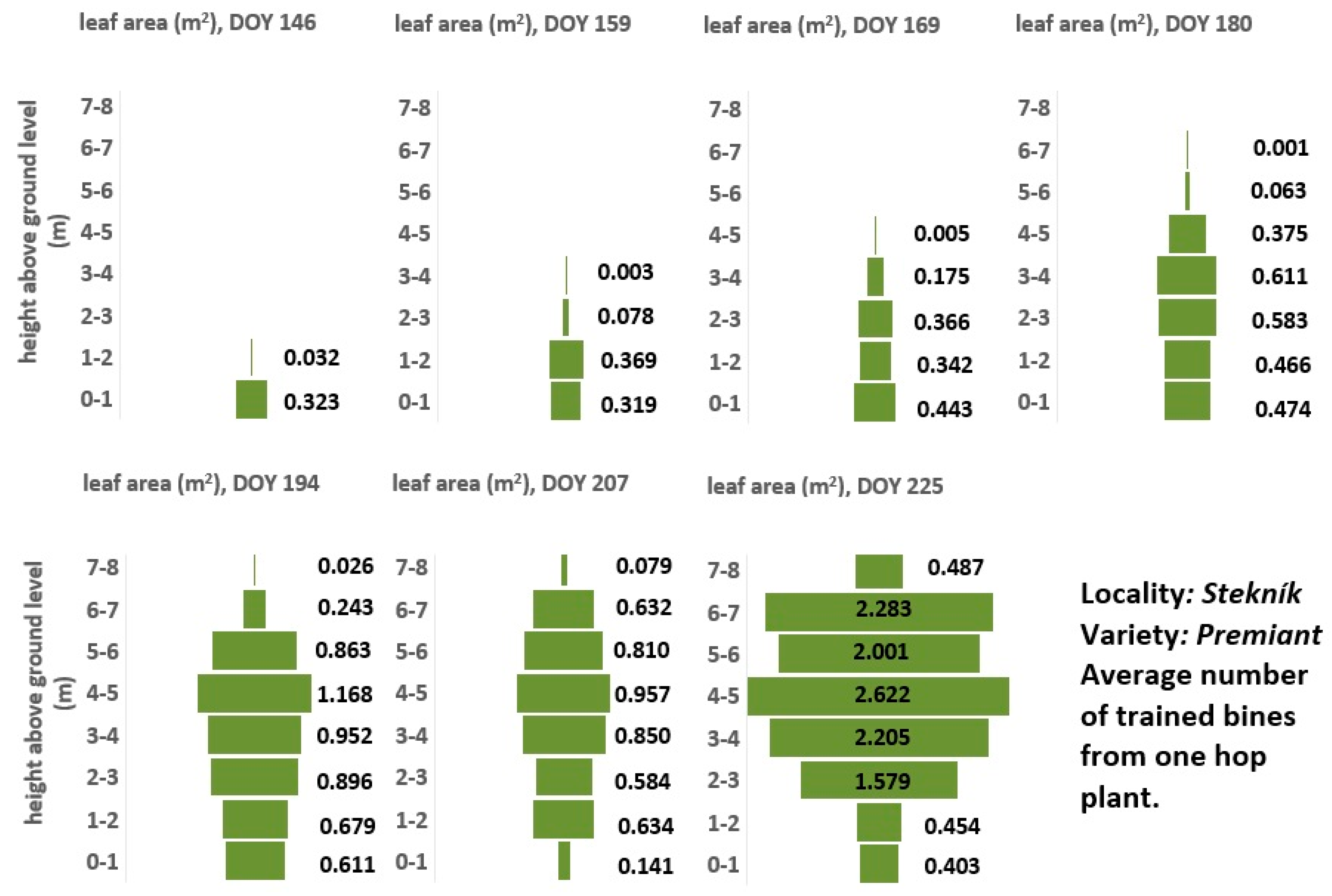Relationship Between Dynamics of Plant Biometric Parameters and Leaf Area Index of Hop (Humulus lupulus L.) Plants
Abstract
1. Introduction
2. Materials and Methods
2.1. Location and Structure of the Hop Plantation
2.2. Determination of Leaf Area Using Infrared Imaging
2.3. Determination of Leaf Area Using Gravimetric Method
2.4. Determination of Biomass Production
2.5. Comparison of Methods and Biometric Correlations
2.6. Statistical Evaluation
3. Results and Discussion
3.1. Comparison of Two Different Approaches for Leaf Area Determination
3.2. Spatial Distribution of Leaves and the Dynamics of Leaf Area Development During the Ontogenesis of Hop Plants
3.3. Assessment of the Production of Dry Aboveground Biomass from Individual Plant Organs
3.4. Dependence Between the Leaf Area of Bine and Lateral Leaves in Relation to Their Dry Biomass
4. Conclusions
Author Contributions
Funding
Data Availability Statement
Conflicts of Interest
Abbreviations
| BP | Breaking point |
| DOY | Day of year |
| LA | Leaf area |
| LAI | Leaf area index |
| GPS | Global Positioning System |
| BBCH | Biologische Bundesanstalt, Bundessorenamt and Chemical industry |
| LABL | Leaf area of bine leaves |
| LALL | leaf area of lateral leaves |
| Mpx | Megapixel |
| DB | dry biomass |
| LAIR | leaf area using infrared imaging method |
| LAM | Leaf area mass gravimetric determination |
| UAV | unmanned aerial vehicles |
| SLA | specific leaf area |
References
- Fărcaş, A.C.; Socaci, S.A.; Mudura, E.; Dulf, F.V.; Vodnar, D.C.; Tofană, M.; Salanță, L.C. Exploitation of Brewing Industry Wastes to Produce Functional Ingredients. In Brewing Technology; IntechOpen: London, UK, 2017. [Google Scholar] [CrossRef]
- Kerby, C.; Vriesekoop, F. An Overview of the Utilisation of Brewery By-Products as Generated by British Craft Breweries. Beverages 2017, 3, 24. [Google Scholar] [CrossRef]
- Mongelli, A.; Rodolfi, M.; Ganino, T.; Marieschi, M.; Dall’Asta, C.; Bruni, R. Italian hop germplasm: Characterization of wild Humulus lupulus L. genotypes from Northern Italy by means of phytochemical, morphological traits and multivariate data analysis. Ind. Crops Prod. 2015, 70, 16–27. [Google Scholar] [CrossRef]
- Abram, V.; Čeh, B.; Vidmar, M.; Hercezi, M.; Lazić, N.; Bucik, V.; Možina, S.S.; Košir, I.J.; Kač, M.; Demšar, L.; et al. A comparison of antioxidant and antimicrobial activity between hop leaves and hop cones. Ind. Crops Prod. 2015, 64, 124–134. [Google Scholar] [CrossRef]
- Kong, R.; Yin, J. Efficacy of subcutaneous immunotherapy in a mouse model of Humulus pollen-induced allergic asthma. Am. J. Transl. Res. 2019, 11, 280–289. [Google Scholar]
- Rachwał, K.; Waśko, A.; Gustaw, K.; Polak-Berecka, M. Utilization of brewery wastes in food industry. Peer J. 2020, 8, e9427. [Google Scholar] [CrossRef]
- Pereira, O.R.; Santos, G.; Sousa, M.J. Hop By-Products: Pharmacological Activities and Potential Application as Cosmetics. Cosmetics 2022, 9, 139. [Google Scholar] [CrossRef]
- Hejnák, V.; Hniličková, H.; Hnilička, F. Effect of ontogeny, heterophylly and leaf position on the gas exchange of the hop plant. Plant Soil Environ. 2014, 60, 525–530. [Google Scholar] [CrossRef]
- Kenny, S. Photosynthetic measurements in hop (Humulus). Acta Hortic. 2005, 668, 241–248. [Google Scholar] [CrossRef]
- Wullschleger, S.D.; Oosterhuis, D.M. Photosynthesis of individual field-grown cotton leaves during ontogeny. Photosynth. Res. 1990, 23, 163–170. [Google Scholar] [CrossRef]
- Buttaro, D.; Rouphael, Y.; Rivera, C.M.; Colla, G.; Gonnella, M. Simple and accurate allometric model for leaf area estimation in Vitis vinifera L. genotypes. Photosynthetica 2015, 53, 342–348. [Google Scholar] [CrossRef]
- Daughtry, C.S.T. Direct measurements of canopy structure. Remote Sens. Rev. 1990, 5, 45–60. [Google Scholar] [CrossRef]
- Gower, S.T.; Kucharik, C.J.; Norman, J.M. Direct and Indirect Estimation of Leaf Area Index, fAPAR, and Net Primary Production of Terrestrial Ecosystems. Remote Sens. Environ. 1990, 70, 29–51. [Google Scholar] [CrossRef]
- Küßner, R.; Mosandl, R. Comparison of direct and indirect estimation of leaf area index in mature Norway spruce stands of eastern Germany. Can. J. For. Res. 2000, 30, 440–447. [Google Scholar] [CrossRef]
- Le Roux, X.; Sinoquet, H.; Vandame, M. Spatial distribution of leaf dry weight per area and leaf nitrogen concentration in relation to local radiation regime within an isolated tree crown. Tree Physiol. 1999, 19, 181–188. [Google Scholar] [CrossRef] [PubMed]
- Brant, V.; Zábranský, P.; Škeříková, M.; Pivec, J.; Kroulík, M.; Procházka, L. Effect of row width on splash erosion and throughfall in silage maize crops. Soil Water Res. 2017, 12, 39–50. [Google Scholar] [CrossRef]
- Demirsoy, H.; Demirsoy, L.; Uzun, S.; Ersoy, B. Non-destructive leaf area estimation in peach. Eur. J. Hortic. Sci. 2004, 69, 144–146. [Google Scholar]
- Campbell, G.S. Extinction coefficients for radiation in plant canopies calculated using an ellipsoidal inclination angle distribution. Agric. For. Meteorol. 1986, 36, 317–321. [Google Scholar] [CrossRef]
- Neinavaz, E.; Skidmore, A.K.; Darvishzadeh, R.; Groen, T.A. Retrieval of leaf area index in different plant species using thermal hyperspectral data. ISPRS J. Photogramm. Remote Sens. 2016, 119, 390–401. [Google Scholar] [CrossRef]
- Watson, D.J. Comparative Physiological Studies on the Growth of Field Crops, I. Variation in Net Assimilation Rate and Leaf Area between Species and Varieties, and within and between Years. Ann. Bot. 1947, 11, 41–76. [Google Scholar] [CrossRef]
- Bréda, N.J.J. Ground-based measurements of leaf area index: A review of methods, instruments and current controversies. J. Exp. Botany 2003, 54, 2403–2417. [Google Scholar] [CrossRef]
- Alam, M.S.; Lamb, D.W.; Warwick, N.W.M. A Canopy Transpiration Model Based on Scaling Up Stomatal Conductance and Radiation Interception as Affected by Leaf Area Index. Water 2021, 13, 252. [Google Scholar] [CrossRef]
- Li, X.; Yang, P.; Ren, S.; Li, Y.; Liu, H.; Du, J.; Li, P.; Wang, C.; Ren, L. Modeling cherry orchard evapotranspiration based on an improved dual-source model. Agric. Water Manag. 2010, 98, 12–18. [Google Scholar]
- Barclay, H.J. Conversion of total leaf area to projected leaf area in lodgepole pine and Douglas-fir. Tree Physiol. 1998, 18, 185–193. [Google Scholar] [CrossRef] [PubMed]
- Bréda, N.J.J.; Index, L.A.; Jørgensen, S.E.; Fath, B.D. (Eds.) Encyclopedia of Ecology; Academic Press: Cambridge, MA, USA, 2008; pp. 2148–2154. [Google Scholar] [CrossRef]
- Davie, T.J.A.; Durocher, M.G. A model to consider the spatial variability of rainfall partitioning within deciduous canopy. II. Model parameterisation and testing. Hydrol. Process. 1997, 11, 1525–1540. [Google Scholar] [CrossRef]
- Foody, G.M. Status of land cover classification accuracy assessment. Remote Sens. Environ. 2002, 80, 185–201. [Google Scholar] [CrossRef]
- Turner, D.P.; Cohen, W.B.; Kennedy, R.E.; Fassnacht, K.S.; Briggs, J.M. Relationships between Leaf Area Index and Landsat TM Spectral Vegetation Indices across Three Temperate Zone Sites. Remote Sens. Environ. 1999, 70, 52–68. [Google Scholar] [CrossRef]
- Sachl, J.; Kopecký, J. The height of the hop trellises and the treatment of the growth. Chmelařství 1976, 49, 25–27. (In Czech) [Google Scholar]
- Rybáček, V. Hop Production; Elsevier: Amsterdam, The Netherlands, 1991; ISBN 0-444-98770-3. [Google Scholar]
- Brant, V.; Krofta, K.; Kroulík, M.; Procházka, P.; Zábranský, P.; Vopravil, J.; Kabelka, D.; Ježek, J. Agrotechnical Measures Respecting the Distribution of the Root System of Hops; Agrární komora ČR: Prague, Czech Republic, 2021. (In Czech) [Google Scholar]
- Vopravil, J.; Brant, V.; Kroulík, M.; Krofta, K.; Kabelka, D.; Krofta, K.; Dreksler, J.; Procházka, P.; Kincl, D.; Zábranský, P. Optimization of Soil Tillage in Hop Gardens for the Purpose of Promoting Water Infiltration and Protecting the Soil from Degradation Processes; Kurent: Prague, Czech Republic, 2022. (In Czech) [Google Scholar]
- Hniličková, H.; Hnilička, F.; Novák, V. Leaf area development in irrigated and non-irrigated hop plants. Chmelařství 2000, 3, 44–46. (In Czech) [Google Scholar]
- Rossbauer, G.; Buhr, L.; Hack, H.; Hauptmann, S.; Klose, R.; Meier, U.; Stauss, R.; Weber, E. Phänologische Entwicklungsstadien von Kultur-Hopfen (Humulus lupulus L.). Nachrichtenblatt Des Dtsch. Pflanzenschutzdienstes 1995, 47, 249–253. [Google Scholar]
- Wolf, D.D.; Carson, E.W.; Brown, R.H. Leaf Area Index and Specific Leaf Area Determinations. J. Agric. Educ. 1972, 1, 24–27. [Google Scholar]
- Zheng, G.; Moskal, L.M. Retrieving Leaf Area Index (LAI) Using Remote Sensing: Theories, Methods and Sensors. Sensors 2009, 9, 2719–2745. [Google Scholar] [CrossRef] [PubMed]
- Viña, A.; Gitelson, A.A.; Nguy-Robertson, A.L.; Peng, Y. Comparison of different vegetation indices for the remote assessment of green leaf area index of crops. Remote Sens. Environ. 2011, 115, 3468–3478. [Google Scholar] [CrossRef]
- Clark, S.M.; Vaitheeswaran, V.; Ambrose, S.J.; Purves, R.W.; Page, J.E. Transcriptome analysis of bitter acid biosynthesis and precursor pathways in hop (Humulus lupulus). BMC Plant Biol. 2013, 13, 12. [Google Scholar] [CrossRef] [PubMed]
- Wang, G.; Tian, L.; Aziz, N.; Broun, P.; Dai, X.; He, J.; King, A.; Zhao, P.X.; Dixon, R.A. Terpene Biosynthesis in Glandular Trichomes of Hop. Plant Physiol. 2008, 148, 1254–1266. [Google Scholar] [CrossRef]
- Bauerle, W.L. Humulus lupulus L. Strobilus Photosynthetic Capacity and Carbon Assimilation. Plants 2023, 12, 1816. [Google Scholar] [CrossRef]
- Škeříková, M.; Brant, V.; Kroulík, M.; Pivec, J.; Zábranský, P.; Hakl, J.; Hofbauer, M. Water demands and biomass production of sorghum and maize plants in areas with insufficient precipitation in Central Europe. Plant Soil Environ. 2018, 64, 367–378. [Google Scholar] [CrossRef]
- Wullschleger, S.D.; Oosterhuis, D.M. Canopy Leaf Area and Age-Class Dynamics in Cotton. Crop Sci. 1992, 32, 451–456. [Google Scholar]
- Asner, G.P.; Scurlock, J.M.O.; Hicke, J.A. Global synthesis of leaf area index observations: Implications for ecological and remote sensing studies. Glob. Ecol. Biogeogr. 2003, 12, 191–205. [Google Scholar] [CrossRef]
- Krofta, K.; Pokorný, J. Hop cultivation vs. Weather—An eternal theme: (Evaluation of the crop harvest 2019–2022 of Czech hop varieties at Stekník farm). Kvas. Prum. 2023, 69, 822–830. [Google Scholar] [CrossRef]
- Timlin, D.J.; Fleisher, D.H.; Kemanian, A.R.; Reddy, V.R. Plant density and leaf area index effects on the distribution of light transmittance to the soil surface in maize. Agron. J. 2014, 106, 1827–1837. [Google Scholar]
- Krofta, K.; Fritschová, G.; Mikyška, A.; Belešová, K.; Vojtěchová, D.; Tichá, J. Alpha acids content in Czech hops from the harvest of 2021—Forecast, reality, trends. Kvas. Prum. 2022, 68, 564–571. [Google Scholar] [CrossRef]
- Krofta, K.; Patzak, J.; Sedlák, T.; Mikyška, A.; Štěrba, K.; Jurková, M. Kazbek—The First Czech Aroma “Flavor Hops” Variety: Characteristics and Utilization. Kvas. Prum. 2019, 65, 72–83. [Google Scholar] [CrossRef]
- Probasco, E.G.; Murphey, J.M. The effect of hop viruses on brewing and agronomic characteristics in the hop variety Chinook. Tech. Q. Master Brew. Am. 1996, 33, 160–165. [Google Scholar]
- Cotton, C.A.; Edlich-Muth, C.; Bar-Even, A. Reinforcing carbon fixation: CO2 reduction replacing and supporting carboxylation. Curr. Opin. Biotechnol. 2018, 49, 49–56. [Google Scholar] [CrossRef] [PubMed]
- Kross, A.; McNairn, H.; Lapen, D.; Sunohara, M.; Champagne, C. Assessment of RapidEye vegetation indices for estimation of leaf area index and biomass in corn and soybean crops. Int. J. Appl. Earth Obs. Geoinf. 2015, 34, 235–248. [Google Scholar] [CrossRef]
- Oliveira, R.A.; Junior, J.M.; Costa, C.S.; Näsi, R.; Koivumäki, N.; Niemeläinen, O.; Kaivosoja, J.; Nyholm, L.; Pistori, H.; Honkavaara, E. Silage Grass Sward Nitrogen Concentration and Dry Matter Yield Estimation Using Deep Regression and RGB Images Captured by UAV. Agronomy 2022, 12, 1352. [Google Scholar] [CrossRef]
- Apolo-Apolo, O.E.; Pérez-Ruiz, M.; Martínez-Guanter, J.; Egea, G. A Mixed Data-Based Deep Neural Network to Estimate Leaf Area Index in Wheat Breeding Trials. Agronomy 2020, 10, 175. [Google Scholar] [CrossRef]
- Tang, Z.; Guo, J.; Xiang, Y.; Lu, X.; Wang, Q.; Wang, H.; Cheng, M.; Wang, H.; Wang, X.; An, J.; et al. Estimation of Leaf Area Index and Above-Ground Biomass of Winter Wheat Based on Optimal Spectral Index. Agronomy 2022, 12, 1729. [Google Scholar] [CrossRef]








| Evaluation Date 2019 (DOY) | BBCH | The Number of Evaluated Bines | Evaluation Date 2020 (DOY) | BBCH | The Number of Evaluated Bines | Evaluation Date 2021 (DOY) | BBCH | The Number of Evaluated Bines |
|---|---|---|---|---|---|---|---|---|
| 135 | 32 | 5 | 140 | 34 | 4 | 146 | 33 | 5 |
| 144 | 35 | 5 | 149 | 36 | 4 | 159 | 36 | 3 |
| 156 | 36 | 5 | 161 | 37 | 4 | 169 | 37 | 3 |
| 163 | 37 | 3 | 176 | 38 | 3 | 180 | 38 | 2 |
| 172 | 38 | 3 | 195 | 68 | 3 | 194 | 62 | 2 |
| 183 | 39 | 3 | 224 | 83 | 2 | 207 | 68 | 2 |
| 200 | 64 | 3 | 241 | 89 | 2 | 225 | 82 | 2 |
| 225 | 82 | 1 | – | – | – | – | – | – |
| Year | DOY | BBCH | Total LA per Bine (m2) | Total LA per Plant * (m2) | Proportion of Bine Leaves (%) | LAI |
|---|---|---|---|---|---|---|
| 2019 | 135 | 32 | 0.066 | 0.266 | 100 | 0.089 |
| 2020 | 140 | 34 | 0.146 | 0.585 | 100 | 0.195 |
| 2021 | 146 | 33 | 0.089 | 0.355 | 100 | 0.118 |
| Year | DOY | BBCH | Total LA per Bine (m2) | Total LA per Plant * (m2) | Proportion of Bine Leaves (%) | LAI |
|---|---|---|---|---|---|---|
| 2019 | 225 | 82 | 2.613 | 10.451 | 35.0 | 3.48 |
| 2020 | 241 | 89 | 1.663 | 6.652 | 36.9 | 2.22 |
| 2021 | 225 | 82 | 3.009 | 12.038 | 49.0 | 4.01 |
| Year | 2019 | 2020 | 2021 | ||||||||||||||||||
|---|---|---|---|---|---|---|---|---|---|---|---|---|---|---|---|---|---|---|---|---|---|
| DOY | 144 | 156 | 163 | 172 | 183 | 200 | 225 | 140 | 149 | 161 | 176 | 195 | 224 | 241 | 146 | 159 | 169 | 180 | 194 | 207 | 225 |
| Plant parts | Proportion of plant parts to total plant biomass (%) | ||||||||||||||||||||
| Bine stem | 42.0 | 40.5 | 36.6 | 35.8 | 40.5 | 35.5 | 22.8 | 44.8 | 44.4 | 43.8 | 43.9 | 40.6 | 28.8 | 31.2 | 41.0 | 45.8 | 41.3 | 40.8 | 33.9 | 40.8 | 28.7 |
| Bine leaves | 47.7 | 42.6 | 37.4 | 29.2 | 23.7 | 18.2 | 10.1 | 48.2 | 50.2 | 37.6 | 39.1 | 27.1 | 14.4 | 15.3 | 51.7 | 48.1 | 41.7 | 35.8 | 25.0 | 21.7 | 12.8 |
| Lateral leaves | 0 | 0 | 9.3 | 14.7 | 17.2 | 21.2 | 16.9 | 0 | 0 | 9.0 | 7.9 | 14.6 | 19.0 | 17.9 | 0 | 0 | 6.5 | 9.6 | 18.7 | 16.4 | 22.2 |
| Lateral stems with petioles | 3.2 | 11.1 | 12.0 | 17.0 | 16.1 | 23.2 | 16.3 | 0 | 0 | 4.9 | 3.9 | 14.7 | 13.6 | 19.3 | 0 | 0 | 5.8 | 10.5 | 19.8 | 18.9 | 28.8 |
| Petioles of bine leaves | 7.1 | 5.7 | 4.6 | 3.3 | 2.5 | 1.9 | 0.8 | 7.1 | 5.4 | 4.8 | 5.3 | 3.0 | 1.2 | 2.1 | 7.3 | 6.1 | 4.7 | 3.4 | 2.5 | 2.1 | 1.1 |
| Hop cones | 0 | 0 | 0 | 0 | 0 | 0 | 33.1 | 0 | 0 | 0 | 0 | 0 | 23.1 | 14.2 | 0 | 0 | 0 | 0 | 0 | 0 | 6.4 |
| Dry biomass production of plant/stand | |||||||||||||||||||||
| Production of aboveground dry biomass of the plant (kg) | 0.068 | 0.124 | 0.389 | 0.576 | 0.914 | 1.114 | 2.655 | 0.064 | 0.108 | 0.203 | 0.289 | 0.739 | 1.341 | 1.557 | 0.032 | 0.078 | 0.157 | 0.320 | 0.858 | 0.839 | 2.014 |
| Production of aboveground dry biomass of stand (t/ha) | 0.227 | 0.412 | 1.296 | 1.920 | 3.046 | 3.714 | 8.850 | 0.215 | 0.358 | 0.678 | 0.964 | 2.462 | 4.470 | 5.189 | 0.108 | 0.260 | 0.525 | 1.067 | 2.859 | 2.798 | 6.715 |
| Year/Period (DOY) | |||
|---|---|---|---|
| Algorithm | r | R2 | BP Day (DOY) |
| 2019/135–225 | |||
| DBBL = −0.3786 + 0.0030*DOY | 0.939 | – | 190 |
| DBLL = −1.0039 + 0.0063*DOY | 0.994 | – | |
| DBBL = 0.2025 + 0.0571*ln(DBplant) | – | 95.8 | |
| DBLL = −0.0127 + 0.1799*DBplant | 0.988 | – | |
| 2020/140–241 | |||
| DBBL = −0.2467 + 0.0021*DOY | 0.963 | – | 181 |
| DBLL = −0.5166 + 0.0033*DOY | 0.972 | – | |
| DBBL = 0.1971 + 0.0641*ln(DBplant) | – | 95.8 | |
| DBLL = −0.0277 + 0.2002*DBplant | 0.997 | – | |
| 2021/146–225 | |||
| DBBL = −0.4634 + 0.0032*DOY | 0.963 | – | 195 |
| DBLL = −1.0478 + 0.0062*DOY | 0.909 | – | |
| DBBL = 0.2028 + 0.0618*ln(DBplant) | – | 95.6 | |
| DBLL = −0.0347 + 0.2332*DBplant | 0.996 | – |
| Year | Period (DOY) | Linear Model | r | n |
|---|---|---|---|---|
| 2019–2021 | up to 180 | LABL = 0.0036 + 0.0176*DBBL | 0.982 | 57 |
| average | LALL = −0.0003 + 0.0186*DBLL | 0.958 | 27 | |
| LALtotal = 0.0009 + 0.0184*DBLtotal | 0.988 | 57 | ||
| from day 180 onwards | LABL = −0.0278 + 0.0218*DBBL | 0.892 | 72 | |
| LALL = 0.0180 + 0.0127*DBLL | 0.952 | 70 | ||
| LALtotal = 0.0115 + 0.0145*DBLtotal | 0.965 | 72 |
Disclaimer/Publisher’s Note: The statements, opinions and data contained in all publications are solely those of the individual author(s) and contributor(s) and not of MDPI and/or the editor(s). MDPI and/or the editor(s) disclaim responsibility for any injury to people or property resulting from any ideas, methods, instructions or products referred to in the content. |
© 2025 by the authors. Licensee MDPI, Basel, Switzerland. This article is an open access article distributed under the terms and conditions of the Creative Commons Attribution (CC BY) license (https://creativecommons.org/licenses/by/4.0/).
Share and Cite
Brant, V.; Krofta, K.; Zábranský, P.; Hamouz, P.; Procházka, P.; Dreksler, J.; Kroulík, M.; Fritschová, G. Relationship Between Dynamics of Plant Biometric Parameters and Leaf Area Index of Hop (Humulus lupulus L.) Plants. Agronomy 2025, 15, 823. https://doi.org/10.3390/agronomy15040823
Brant V, Krofta K, Zábranský P, Hamouz P, Procházka P, Dreksler J, Kroulík M, Fritschová G. Relationship Between Dynamics of Plant Biometric Parameters and Leaf Area Index of Hop (Humulus lupulus L.) Plants. Agronomy. 2025; 15(4):823. https://doi.org/10.3390/agronomy15040823
Chicago/Turabian StyleBrant, Václav, Karel Krofta, Petr Zábranský, Pavel Hamouz, Pavel Procházka, Jiří Dreksler, Milan Kroulík, and Gabriela Fritschová. 2025. "Relationship Between Dynamics of Plant Biometric Parameters and Leaf Area Index of Hop (Humulus lupulus L.) Plants" Agronomy 15, no. 4: 823. https://doi.org/10.3390/agronomy15040823
APA StyleBrant, V., Krofta, K., Zábranský, P., Hamouz, P., Procházka, P., Dreksler, J., Kroulík, M., & Fritschová, G. (2025). Relationship Between Dynamics of Plant Biometric Parameters and Leaf Area Index of Hop (Humulus lupulus L.) Plants. Agronomy, 15(4), 823. https://doi.org/10.3390/agronomy15040823






